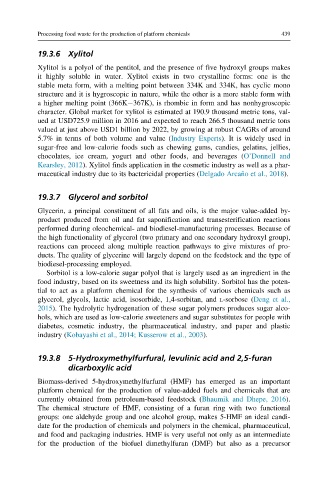Page 482 - Refining Biomass Residues for Sustainable Energy and Bioproducts
P. 482
Processing food waste for the production of platform chemicals 439
19.3.6 Xylitol
Xylitol is a polyol of the pentitol, and the presence of five hydroxyl groups makes
it highly soluble in water. Xylitol exists in two crystalline forms: one is the
stable meta form, with a melting point between 334K and 334K, has cyclic mono
structure and it is hygroscopic in nature, while the other is a more stable form with
a higher melting point (366K 367K), is rhombic in form and has nonhygroscopic
character. Global market for xylitol is estimated at 190.9 thousand metric tons, val-
ued at USD725.9 million in 2016 and expected to reach 266.5 thousand metric tons
valued at just above USD1 billion by 2022, by growing at robust CAGRs of around
5.7% in terms of both volume and value (Industry Experts). It is widely used in
sugar-free and low-calorie foods such as chewing gums, candies, gelatins, jellies,
chocolates, ice cream, yogurt and other foods, and beverages (O’Donnell and
Kearsley, 2012). Xylitol finds application in the cosmetic industry as well as a phar-
maceutical industry due to its bactericidal properties (Delgado Arcan ˜o et al., 2018).
19.3.7 Glycerol and sorbitol
Glycerin, a principal constituent of all fats and oils, is the major value-added by-
product produced from oil and fat saponification and transesterification reactions
performed during oleochemical- and biodiesel-manufacturing processes. Because of
the high functionality of glycerol (two primary and one secondary hydroxyl group),
reactions can proceed along multiple reaction pathways to give mixtures of pro-
ducts. The quality of glycerine will largely depend on the feedstock and the type of
biodiesel-processing employed.
Sorbitol is a low-calorie sugar polyol that is largely used as an ingredient in the
food industry, based on its sweetness and its high solubility. Sorbitol has the poten-
tial to act as a platform chemical for the synthesis of various chemicals such as
glycerol, glycols, lactic acid, isosorbide, 1,4-sorbitan, and L-sorbose (Deng et al.,
2015). The hydrolytic hydrogenation of these sugar polymers produces sugar alco-
hols, which are used as low-calorie sweeteners and sugar substitutes for people with
diabetes, cosmetic industry, the pharmaceutical industry, and paper and plastic
industry (Kobayashi et al., 2014; Kusserow et al., 2003).
19.3.8 5-Hydroxymethylfurfural, levulinic acid and 2,5-furan
dicarboxylic acid
Biomass-derived 5-hydroxymethylfurfural (HMF) has emerged as an important
platform chemical for the production of value-added fuels and chemicals that are
currently obtained from petroleum-based feedstock (Bhaumik and Dhepe, 2016).
The chemical structure of HMF, consisting of a furan ring with two functional
groups: one aldehyde group and one alcohol group, makes 5-HMF an ideal candi-
date for the production of chemicals and polymers in the chemical, pharmaceutical,
and food and packaging industries. HMF is very useful not only as an intermediate
for the production of the biofuel dimethylfuran (DMF) but also as a precursor

